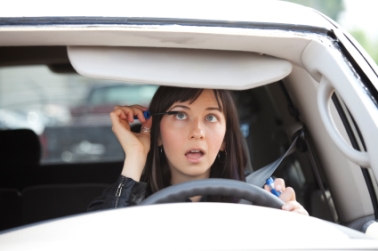Five bad driving habits to give up for Lent
Linda Melone
During the season of Lent, the 40 days leading up to Easter, many Catholics vow to give up something indulgent as a form of sacrifice or penance. Some may give up sweets while others promise to change a bad habit.
Whether you’re Catholic or not, giving up bad driving habits for 40 days may enable you to stick with it for good – and might pay off in the form of lower car insurance premiums.
Here are five bad driving habits to give up for Lent.
1. Being in a hurry.
The insurance cost: Getting ticketed for speeding can boost your insurance rates, but the amount of the increase depends on how many miles you were traveling over the posted speed limit, says Jim Pihl, a Florida territory owner at Brightway Insurance.
 For example, going 14 miles per hour over the posted speed limit in
For example, going 14 miles per hour over the posted speed limit in
Try this instead: To avoid rushing, prepare for work the night before, suggests Elizabeth Lombardo, author of “A Happy You: Your Ultimate Prescription for Happiness.” She says: “Pick out your outfit the night prior and place your briefcase near the door along with your keys.”
2. Using your car as a rolling vanity.
The insurance cost: Distracted driving, whether you’re applying makeup or fixing your hair, can result in a minor moving violation in some states and can hike your insurance rates by 3 percent to 5 percent if you’re ticketed, Pihl says. A 2006 study by the Virginia Tech Transportation Institute found that a driver’s crash risk rises by three times when a driver touches up her makeup; talking on the phone bumps up the risk by just 1.3 times.
Try this instead: Women drivers should take the time to apply makeup before leaving the house. “You’ll look better, too,” Lombardo says.
3. Following too closely.
The insurance cost: You’re at fault in 99 percent of cases if you hit another car from behind, insurance consultant Dan Weedin says. “The only exception may be if the person in front of you backed up into you,” he says. Whether a single at-fault wreck raises your rates depends on your insurer. “Some companies have accident forgiveness, where they won’t raise your rates if you go, say, five years without an accident,” Weedin says.
Try this instead: If you’re driving under 35 mph, stay 2 seconds behind the car in front of you, 3 seconds if you’re driving 36 to 45 mph and 4 seconds if you’re traveling between 46 and 70 mph. Count the seconds as the car in front of you passes a stationary object. Allow even more space in rainy or snowy weather.
4. Treating your car as an all-you-can-eat buffet.
The insurance cost: Eating while driving falls under “distracted driving,” according to the National Highway Traffic Safety Administration (NHTSA), and is nearly as dangerous as dialing a cellphone. “We see distracted driving accidents much more with younger drivers,” Pihl says. If distracted driving leads to a crash, your premium easily could go up – whether you’re a teen or adult driver. If the hike is 20 percent on an annual premium of $3,000, that’s $600 more out of your pocket.
Try this instead: Avoid multitasking of any type while driving. “When we are driving, we should be focused on driving and putting the safety of our passengers and others on the roads first,” says FocusDriven, a nonprofit group that advocates for cellphone-free driving. “Everything else must be dealt with before we begin our trip or put on hold till we’ve safely reached our destination.”
5. Taking out your frustrations on other drivers.
The insurance cost: Driving when angry sets the stage for aggressive driving, which NHTSA defines as moving violations that endanger people or property. Definitions vary from state to state, but typically this includes unsafe lane changes, following too closely, failing to signal and passing a stopped school bus, according to the Governors Highway Safety Association.
If a driver gets into an accident that’s his or her fault, insurance rates are likely to go up based on the driving-record points that are racked up, Weedin says.
Try this instead: Remember that it’s not up to you to teach other motorists a lesson when you disapprove of their driving, says Gregory Kushnick, a clinical psychologist in New York. “When you attempt to teach someone a lesson (by expressing road rage),” he says, “you become the most dangerous driver on the road.”
